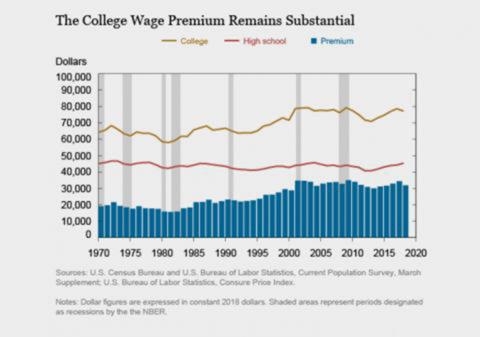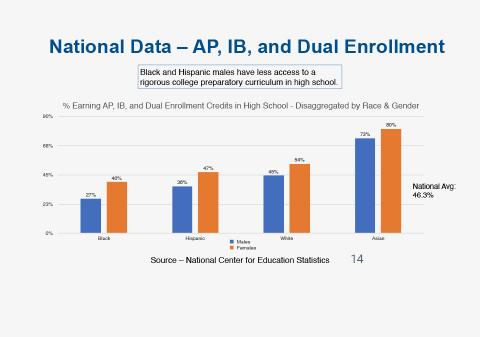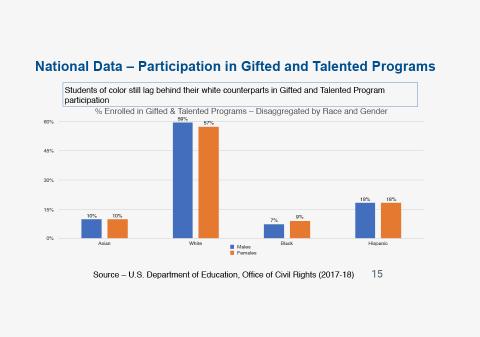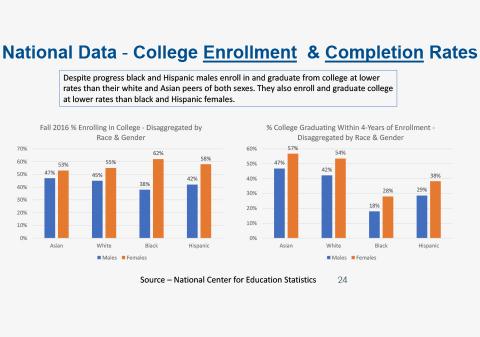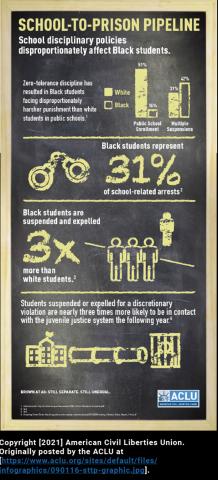
Background
Education has long been viewed as the great equalizer in paving a path to increased opportunity. A quality education,
starting with access to early-learning experiences and continuing through post-secondary education, is strongly correlated to the ability to earn a living wage, live a healthy life and fully participate in civic life. The average college graduate earns $33,000 more annually than the average worker with only a high school diploma. Even accounting for disparities across races, data shows that within races, Black and Hispanic individuals with higher levels of education earn more in their lifetimes and their families achieve higher net wealth than those with less education. Yet access to quality early learning experiences and K-12 education varies significantly based on race, socioeconomic status, and locality.
An equity lens in education shifts the focus from individual experiences to one placing stronger responsibility on the structures, institutions, policies and practices that have contributed to current unequal conditions. To understand present day education gaps and disparities, it is important to consider broader historical policies and practices covering the longitudinal impacts of discriminatory federal policies in housing lending practices, “separate but equal” public education, and discriminatory practices in hiring. All of which have limited educational opportunities to support the upward mobility of people of color.
These historical realities, combined with implicit bias among some educators, and present-day inequities in school funding formulas that rely heavily on local property taxes and
resident wealth, inform current education policies and practices which exacerbate inequities and disparities within and across school systems. These inequities largely disadvantage Black, American Indian and Hispanic students, and advantage their white and Asian counterparts.
Educational disparities start early and grow over time…
The lack of access to quality early childhood programs based on race/ethnicity, affordability, and availability limit the potential of these programs to improve kindergarten readiness and create more equitable educational outcomes in the United States. Although all families struggle to access quality programs, these challenges are intensified in low-income and/or children of color:
Click Below for key data points
- First Key Data Points
-
- 38 percent of Black and American Indian/Alaska Native and 34 percent of Hispanic children are enrolled in Pre-K programs in contrast to 43 percent of white children.
- 60 percent of children in households where at least one parent has an Bachelor’s Degree of higher attends preschool in contrast to 35 percent of children in families where the highest level of education earned is a less than a high school diploma.
- Gaps in access, resources, and opportunities emerge in early education and persist through K-12 and higher education. On average, students of color in the U.S. continue to experience different and unequal education in contrast to their white and Asian counterparts:
- 45 percent of Black and Hispanic, and 41 percent of American Indian/Alaska Native students attend schools where 75 percent or more qualify for Free and Reduced-Price Lunch (FRPL); in contrast only 15 percent of Asian, and 8 percent of white students attend schools with similar concentrations of poverty.
- Inequities in school funding disproportionately impact students of color; these gaps are greater than inequities based on poverty in school systems with the greatest concentration of Black, Hispanic, and American Indian/Alaska Native students. While some state and localities have worked to create more equitable school funding approaches, at a national level, districts serving the greatest number of students of color receive $1,800 less per student in state and local funding than districts with the fewest students of color.
- Researchers have long documented the correlation between teacher quality and student success in school. Students taught by high-quality teachers are more likely to attend college and earn higher incomes. Yet low-income students of color are more likely to be taught by educators that are teaching out of their chosen field, are least experienced, and/or do not hold a teaching credential.
- Despite studies demonstrating positive results when students of color are taught by teachers who share their race/ethnicity, most notably Black students, approximately 80 percent of teachers in the U.S. are white (and largely female). In contrast, the majority of students attending public schools are Black and Hispanic.
- Black and Hispanic students lack access to many core courses considered critical for college access: 25 percent of the schools in the U.S. with the highest enrollment of Black and Hispanic students do not offer Algebra II; one-third do not offer chemistry.
- Black and Hispanic students have less access to the rigorous coursework (e.g., Advanced Placement, IB and dual enrollment) necessary for college and career success. Black and Hispanic students are also under-represented in talented and gifted classes whether they attend schools that predominantly serve students of color or predominantly white schools. This
- phenomenon of “racial tracking” has led to a prevalence of schools within schools, characterized by white and Asian students overwhelmingly placed in gifted and talented, AP and college preparatory courses and their Black and Hispanic counterparts relegated to remedial and/or general education classes.
- Black students are more likely to be retained a grade: 6 percent of all students are retained a grade level, in contrast to 12 percent of Black students. Students of color, and particularly Black students, are more likely to be identified for special education classes and/or to be suspended or expelled from school, suffering harsher punishments for similar behaviors than their white peers.
- Students expelled or suspended from school are far more likely to experience academic failure, be retained a grade or ultimately dropout. School policies resulting in disproportionate pushout of Black males have dire consequences, and often become the starting point for prolonged involvement with juvenile and criminal justice systems.
- Second Key Data Points
-
These conditions contribute to persistent racial disparities in school achievement, college and
career readiness, and engagement:
Reading on grade level is critical to success in school and correlated with graduating high school on time. Despite this, significant gaps in reading proficiency persist: 45 percent of white and 57 percent of Asian 4th graders are proficient, compared to 18 percent of African American, 23 percent of Hispanic, and 19 percent of American Indian 4th graders.
Despite recent progress Black and Hispanic students, particularly males, graduate high school and enroll/graduate from college at lower rates than their white and Asian counterparts.
Significantly higher percentages of Black and Hispanic students are “disconnected” in that they are neither in school nor working. While overall one in nine youth in the U.S. ages 16-24 are considered disconnected 23% of American Indian, 17.4% of Black and 12.8% of Hispanic youth are disconnected.
- Third Key Data Points (Covid-19 Pandemic)
-
The COVID-19 pandemic has exacerbated pre-existing inequities in access, opportunity, achievement and attainment. Students of color are more likely to lack access to the technology necessary to stay engaged in learning as schools have shifted to remote or hybrid instruction, and more likely to be learning outside of the classroom. A recent study found that while all students have experienced learning loss, students of color and low-income students experienced the largest declines in mathematics and reading.
Despite recent progress Black and Hispanic students, particularly males, graduate high school and enroll, and graduate from college at lower rates than their white and Asian counterparts.
Significantly higher percentages of Black and Hispanic students are “disconnected” in that they are neither in school nor working. While overall one in nine youth in the U.S. ages 16-24 are considered disconnected 23 percent of American Indian, 17.4 percent of Black and 12.8 percent of Hispanic youth are disconnected.
The COVID-19 pandemic has exacerbated pre-existing inequities in access, opportunity, achievement and attainment. Students of color are more likely to lack access to the technology necessary to stay engaged in learning as schools have shifted to remote or hybrid instruction, and more likely to be learning outside of the classroom. A recent study found that while all students have experienced learning loss, students of color and low-income students experienced the largest declines in mathematics and reading.


